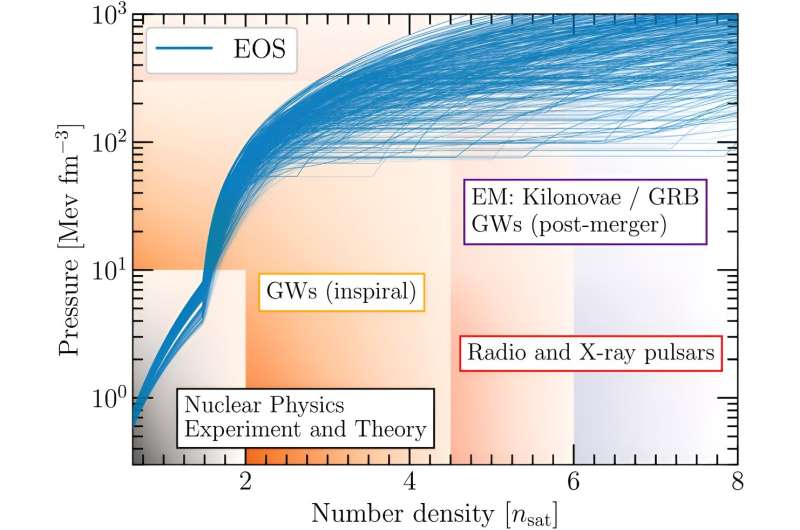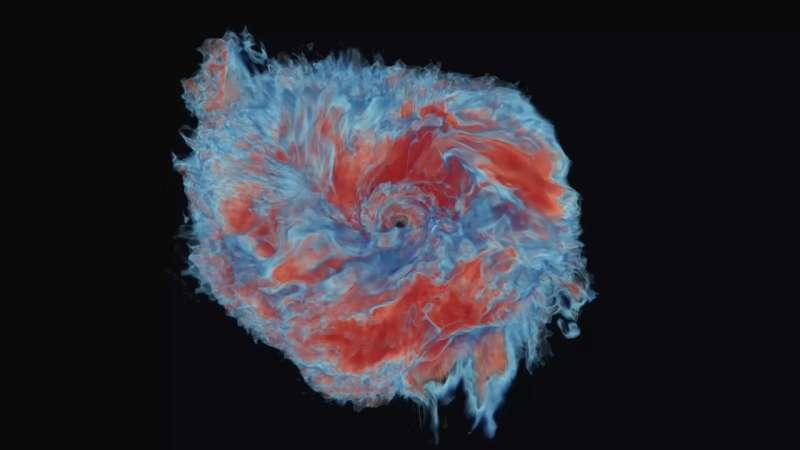Numerical simulation of the ejecta produced by two merging neutron stars. Red refers to ejected material with a high proportion of neutrons, which generally appears redder than blue material with a higher proportion of protons. Image credit: I. Markin (University of Potsdam)
Neutron stars are the end product of massive stars, condensing a large portion of the original stellar mass into ultra-dense stars only about ten kilometers in diameter. On August 17, 2017, researchers observed for the first time multiple signatures of the explosive merger of two orbiting neutron stars: gravitational waves and huge bursts of radiation, including gamma-ray bursts.
An international team of researchers has developed a method to simultaneously simulate the observable signals of these kilonovae. This allowed them to describe precisely what happened during the merger, how nuclear material behaves under extreme conditions, and why the gold on Earth must have been created during such events.
A team from the Max Planck Institute for Gravitational Physics and the University of Potsdam used a new software tool to simultaneously interpret various types of astrophysical data from kilonovae.
In addition, data from radio and X-ray observations of other neutron stars, computational data from nuclear physics, and even data from heavy ion collision experiments at accelerators on Earth can also be used. Until now, the various sources have been analyzed individually and in some cases used different physical models to explain the material.
“By analyzing the data coherently and simultaneously, we get more precise results,” said Peter TH Pang, a scientist at Utrecht University.
“Our new method will help analyze the properties of matter at extreme densities. It will also allow us to better understand the expansion of the universe and the extent to which heavy elements are formed during neutron star mergers,” said Tim Dieter, a professor at the university. Rishi explained. Head of the Max Planck Research Group at the University of Potsdam and the Max Planck Institute for Gravitational Physics.

An overview of EOS constraints from different information channels. We show a set of possible EOSs (blue lines) constrained to 1.5 nsat by quantum Monte Carlo calculations using chiral EFT interactions and extended to higher densities using a sound speed model. Different regions of the EOS can then be constrained by using different astrophysical messengers (represented by rectangles): gravitational waves from NS merger spirals, data from radio and X-ray pulsars, and electromagnetic signals associated with NS mergers. Note that the bounds are not strict but depend on the properties of EOS and the system under study. Credit: nature communications (2023). DOI: 10.1038/s41467-023-43932-6
Extreme conditions in the space laboratory
Neutron stars are ultra-dense objects formed in supernova explosions at the end of the life of a massive star. Like other compact objects, some neutron stars orbit each other in binary star systems. They lose energy by continuously emitting gravitational waves (tiny ripples in the fabric of space-time) and eventually collide.
This merger allows researchers to study physical principles under the most extreme conditions in the universe. For example, the conditions of these high-energy collisions lead to the formation of heavy elements such as gold. In fact, merging neutron stars are unique objects for studying the properties of matter with densities far beyond those of atomic nuclei.
The new method was applied to the first and only multi-messenger observation of a binary neutron star merger to date. In this event, discovered on August 17, 2017, the last few thousand times the stars orbited each other distorted space-time enough to produce gravitational waves, which were detected by the ground-based gravitational wave observatories Advanced LIGO and Advanced Virgo. When two stars merge, the newly formed heavy elements are ejected.
Some of these elements undergo radioactive decay, causing temperatures to rise. Triggered by this thermal radiation, optical, infrared and ultraviolet signals were detected within two weeks of the collision. Gamma-ray bursts, also caused by neutron star mergers, eject additional material. The reaction of neutron star material with the surrounding medium produces X-ray and radio emissions that can be monitored on timescales of days to years.
Provide more accurate results for future testing
The gravitational wave detector is currently conducting its fourth observation. The next detection of a neutron star merger could come any day, and researchers are eagerly waiting to use the tools they have developed.
Works published in journals nature communications.
More information:
Peter TH Pang et al., An updated nuclear physics and multi-messenger astrophysical framework for binary neutron star mergers, nature communications (2023). DOI: 10.1038/s41467-023-43932-6
Provided by the Max Planck Society
citation: Research team simulates different signatures of kilonova explosion simultaneously for the first time (2023, December 21), retrieved December 21, 2023 https://phys.org/news/2023-12-team-signatures-kilonova- explosion-simultaneously. html
This document is protected by copyright. No part may be reproduced without written permission except in the interests of fair dealing for private study or research purposes. Content is for reference only.
#time #research #team #simulated #characteristics #kilonova #explosion #simultaneously
Image Source : phys.org
